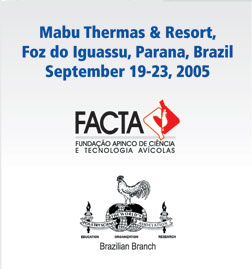COMPARISON OF PERFORMANCE OF ROSS BROILER BREEDER
MALES TO FULL, HALF-DOSE AND 10X DOSE OF COCCIVAC®-D
DAY-OF-AGE VACCINATION
S.W. Davis1, R.A. Phillips2 and C. Broussard2
1Colorado Quality Research, Wellington, Colorado,
USA
steve@coloradoqualityresearch.com
2Schering-Plough Animal Health, Union, New Jersey,
USA
Coccivac®-D
is commonly administered to commercial broiler breeder
replacement pullet and cockerel flocks at a half-dose
of the manufacturer’s recommended dosage in
the theory that the lower dosage results in improved
flock livability and uniformity compared to full dose
administration. This commercial practice of using
the half-dose of Coccivac®-D is most prevalent
in flocks of Ross broiler breeder males. The objective
of this study was to determine if there are differences
in the Ross 344 male broiler breeder in its response
to varying doses of Coccivac-D day-of-age vaccination.
Environmental conditions including floor, feeder and
water space, temperature, lighting, vaccination and
feeding programs were designed to replicate typical
commercial broiler breeder production in the USA industry.
Treatments were compared by 21 day gross coccidiosis
scores, 28 and 70 day body weights, uniformity and
feed conversion and 70 day livability results. The
21 day gross coccidiosis lesion scores resulted in
significantly (P>.05) lower scores in the 10X dose
treatment compared to the half-dose plus Amprol treatment.
Body weights and the individual bird weight uniformity
results were similar and showed no differences between
treatments at 28 and 70 days. There was also no significant
difference between treatments in 70 day livability
results. This study concluded that there were no measurable
performance improvements gained by administering a
half-dose of Coccivac®-D to Ross 344 broiler breeder
males compared to the manufacturer’s recommended
dosage. The investigation shows that multiple doses
(10X) of the vaccine resulted in less 21 day coccidiosis
lesions compared to the half-dose application. These
results may indicate that the lower dosage practice
may inhibit rapid and uniform flock coccidiosis immunity
that could lead to rolling reactions and delayed flock
immunity.
